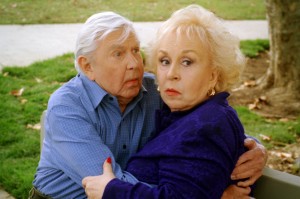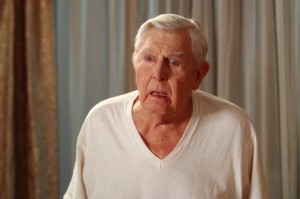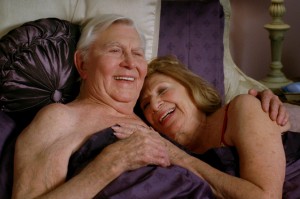CASE STUDY: PLAY THE GAME

Dramatic Feature
Writer/Director/Producer: Marc Fienberg
Budget: $2 million (approx.)
Production: 25 days, Oct–Nov 2007
Financing: Private Equity
Shooting Format: 35mm
Screening Format: 35mm
World Premiere: 2008 Ft. Lauderdale International Film Festival
Awards: 2008 Ft. Lauderdale International Film Festival – Audience Award (Best Indie Feature); 2008 Santa Fe Film Festival – Audience Award; 2009 Daytona Beach Film Festival – Audience Award
Website: www.playthegamemovie.com
Official Synopsis
Play the Game is an original comedy about a young ladies’ man, David, who teaches his dating tricks to his lonely, widowed grandfather Joe, while playing his best mind games to meet Julie, the woman of his dreams. But as David’s supposedly foolproof techniques fail him, Grandpa Joe quickly transforms into the Don Juan of the retirement community.
Slowly, the teacher becomes the student, and it’s up to Grandpa to teach David that the best way to win the game of love is not to play games at all. But both David and Grandpa Joe may have met their match in more ways than one, leading to a surprise twist ending that makes the audience look back at the entire film in a new light.
Development & Financing
In the late 1990s, inspired by the vital social life of his elderly grandfather, writer/director Marc Fienberg began work on a script that would eventually become his first feature, Play the Game. Though it would be nearly twelve years before the project was released in theatres, the strength of the script and a persistent cold submission process netted Fienberg an agent early on in the process.
The project and its creator made the rounds at a dozen Hollywood production companies, only to be told again and again that it simply felt too small to be a major motion picture. Despite the relatively commercial angle of the material, the film looked to Hollywood like an independent, especially considering its potential niche audience of senior citizens.
“I wasn’t trying to produce this movie—I just wanted to sell it,” Fienberg recalls, but with an MBA from Northwestern University’s Kellogg School of Management, he was unafraid to investigate the business side of moviemaking. In 2004, Fienberg moved from Boston to LA to focus on the film, and began to explore fundraising possibilities in earnest, using his business school network to approach hedge funds, venture capitalists, and private equity firms—all without success.
He did stir up interest among high-net-worth individuals, however, and realized that with actor attachments he might be able to secure a significant chunk of his financing from individual investors. Though Fienberg’s Kellogg connections gave him a leg-up in raising funds, it was his unflagging persistence—in the form of countless calls and emails to every possible lead—that allowed him to effectively expand his network. “None of the initial investors were people that I knew before I started raising money,” he says. “Not one.”
During this period, actor James Garner committed to the project, helping Fienberg to close on the initial production budget of approximately $900K from fifteen investors—an accomplishment over four years in the making. But when Fienberg alerted Garner’s agents to the film’s green light, he was crushed to learn that the actor would be unavailable during their projected shoot dates.
“We had a tough decision to make at that point,” Fienberg remembers. Though he wasn’t contractually obligated to return the funds, Fienberg knew that Garner’s attachment had played an enormous role in convincing his investors to participate, so he chose to offer them an out. Happily, not a single one of his backers accepted the offer, and Fienberg was encouraged to recast.

Andy Griffith was just the actor he needed to set the wheels in motion again, but since Griffith didn’t live in Los Angeles—where the film would shoot—his attachment required that the budget be padded to accommodate his travel and housing. Fienberg’s original investors supplied the additional funds, and the writer/director/producer chose to forego his own weekly salary.
Production
Fienberg had planned to shoot the film digitally, but six weeks before filming commenced, Panavision offered to donate free cameras and lenses in hopes of building a relationship with an emerging filmmaker and potential customer for life. When a great deal on film stock from Kodak followed, the director changed his plans and decided to shoot the film on 35mm. Principal photography began in Los Angeles in October of 2007 and continued for five weeks. Because the budget didn’t allow for time on stages, the film was shot entirely on location with a non-union crew, and the first four days of shooting seemed to go smoothly.
But a representative from the crew returned from lunch on the fourth day to inform Fienberg that they had organized and meant to “flip” the shoot—meaning that the crewmembers intended to unionize and would not return to work unless Fienberg consented to pay union rates. He was stunned, and facing a complete production shutdown, was left with two choices: he could hire an entirely new non-union crew on no notice and face the possibility of picketing outside his shoot, or he could start paying union wages. With his budget already stretched to the breaking point, Fienberg knew the latter option wasn’t a real possibility, and set about hiring a new crew immediately, but he reached out to inform his investors nonetheless.
To his surprise, by the late afternoon, his investors had committed the additional funds he would need to retain the original crew, each of whom was then able to join the union. Production was stalled for only four hours in total. “We were very lucky…It was probably the most stressful day of my life, but it had a very happy ending by the end of the day.” Fienberg, who considers himself a union supporter in general, felt it was important to move past the incident quickly and welcomed the crew back.
Festival Preparation and Strategy
Post-production began in November of 2007, and lasted approximately six months in total, during which time Fienberg began the festival application process. He dealt with early rejections from Toronto and Sundance, and quickly realized that the film was up against the opposite side of the same coin that it had faced in Hollywood: Play the Game was an independent movie, but with a commercial bent and an older target audience, it didn’t feel “indie.” This made it a challenging sell for the festivals, but Fienberg was gratified when it was invited to the 2008 Ft. Lauderdale International Film Festival. Premiering the film there was “the best thing we could ever have done, but we didn’t know that at the time.”
Fienberg’s business background was in marketing, and his efforts to promote the film kicked into high gear in late summer of 2008, in preparation for the festival premiere. A publicist, whom had been recommended by one of his investors, offered her services for free and even flew herself in for the event. Fienberg’s entire extended family descended on Ft. Lauderdale, and a number of marketing contacts and interns also volunteered to help get the word out.
The filmmaker even sorted through old emails and called on everyone who’d ever expressed willingness to help. “It was unbelievable what people did for us without any compensation. But by this point we’d literally spent every dollar in the budget.” The team personally introduced the trailer when it screened before other films, and spent long hours making appearances at the festival’s venues and even signing autographs.
In order to target the local senior population, Fienberg’s team developed the “yenta strategy,” enlisting grandmotherly gossips who could get out the word around retirement communities, and the buzz spread like wildfire. “All I really had was my time and sweat equity… But if there was any marketing angle, I found it,” says Fienberg. The Ft. Lauderdale screenings were packed, and the film took home the Audience Award for Best Indie Feature.
Terrific press coverage followed, as did another Audience Award at the Santa Fe Film Festival in November of the same year, but there were no distribution offers on the horizon. They’d found their audience among people 55 and up, and word of mouth continued to build, but Fienberg feared he might spend six months passing screeners around Hollywood only to be told again that elderly people don’t see movies—something he knew to be untrue. Sensing an opportunity, Fienberg made the difficult decision to self-distribute.
The Sale
Fienberg never formally approached distributors, and made the call to self-distribute in December. He was banking on a basic principle of marketing to underserved audiences: “When you do tailor something to them, word of mouth spreads like crazy.” He knew that when temperatures dropped around the country, Florida welcomed huge numbers of senior citizens seeking a warmer climate. If they could release the film in theatres where this audience was concentrated, Fienberg was certain he could reach them, and the national campaign that would follow could capitalize on the word of mouth those audience members would take back with them when they returned to their homes across the country in the spring.
Fienberg hired booker and industry vet Marty Zeidman at Slowhand Releasing, who agreed to get the film into theatres for a reasonable monthly fee and didn’t demand a percentage of the profits. Because this wasn’t an art-house film, Zeidman was careful to place it in more mainstream theatres like AMC, Regal, and Cinemark. Fienberg and Zeidman never four-walled the film, but booked it like any major distributor would, taking a share of ticket sales.
Fienberg approached his original investors again, explaining that those who had equity in this Prints & Advertising phase would receive 20% returns on their additional investment, and would be paid first according to standard film financing procedures (Last in, First out). He raised funds in the low-six figures to cover these P&A costs, and prepared to release in theatres in Florida first, starting in the south Florida area from West Palm Beach to south Miami.
The Release
With timing of major importance, the film was first released on 22 screens in the Ft. Lauderdale area in February of 2009.
Fienberg and his family relocated to the area for two months and conducted aggressive outreach among senior centers, retirement communities, schools, and faith-based groups. To make the most of their advertising budget, they eschewed traditional newspaper ads and focused on Facebook advertising, which allowed them to combine geographic and demographic targeting.

They focused on female seniors within a ten-mile radius of each theatre, and were able to track the ratio of ad clicks to ticket sales. When a particular theatre appeared to be selling well enough during a particular week, Fienberg shifted his resources to concentrate on those that were in danger of underperforming.
The film grossed $50,000 in its first weekend, and later expanded to 53 screens across the state, grossing more than $300K in Florida alone.
A strategic nationwide release followed, in theatres that were accessible to large concentrations of seniors. Allied Advertising took over publicity for this phase, while a freelance publicist handled the Ft. Lauderdale area for a monthly fee of less than $5,000. For the nationwide expansion, Fienberg and his team of interns continued their “find the grandmother” strategy, to target the local elderly social butterflies who would spread the word among the films target demographic more efficiently then an email blast. Fienberg noted that “it’s a lot easier to find the ‘busybody’ in a city than you might think; everyone knows who the busybody is.”
All told, the film played for six months in almost 300 theaters, earning more than $688,000 in box office revenue, making it the third most successful independently distributed domestic feature film of 2009.
As Fienberg took on sales agents to handle ancillary rights, he was careful to select different firms to handle international, VOD, and DVD, hoping to capitalize on their respective strengths and spread his risk, and each charged in the ballpark of 20-30% commissions.
Play The Game has been distributed through VOD in over 65 million households, and a DVD released in the late spring of 2010 is available at WalMart, Blockbuster, and Amazon. Netflix, which Fienberg calls the film’s “greatest success story,” paid in the mid-five figures to stream Play the Game for 18-24 months, and it has accumulated more than 600,000 ratings thus far. Fienberg also collects a per-disc fee and overages from Netflix’s disc-by-mail service, as the film has been a popular rental with customers.
Continuing to target its key demographic, Play the Game has also played on hundreds of cruise ships (rights sold through Swank Motion Pictures ), and even a few airlines (sold through Entertainment in Motion), and continues to screen non-theatrically to retirement groups across the country.
Advice from the Filmmaker
Fienberg advises that the key to filmmaking success lies in not giving up. “The one commonality among successful screenwriters, directors and producers seems to be persistence,” he observes.